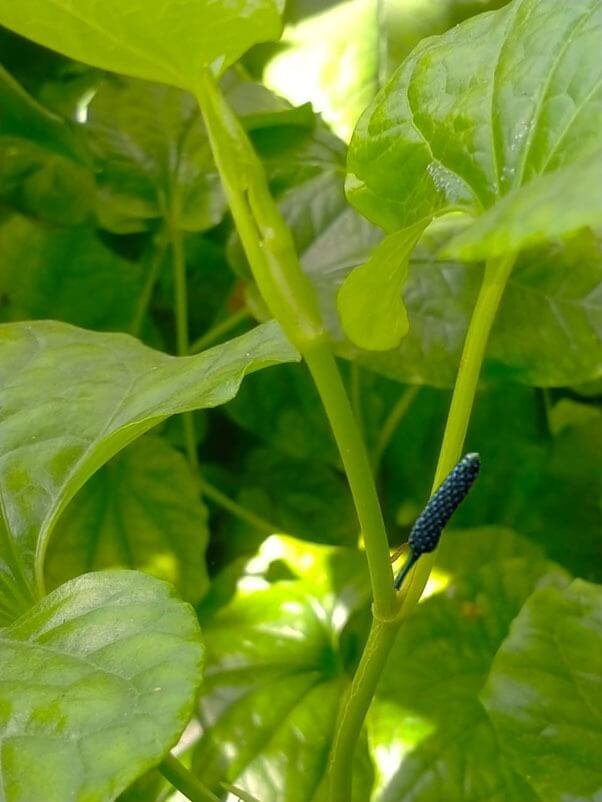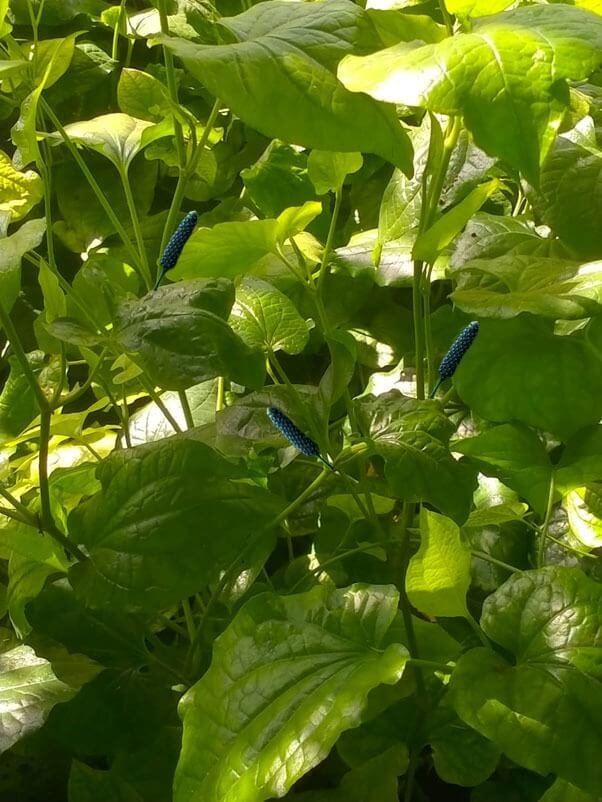Uses and Cultivation of Long pepper (Piper longum)
Long pepper is the dried mature unripe fruits of Piper longum (Linn.) which belongs to family Piperaceae. Roots and thicker stem portion at the base called “Piplamul” are medicinally important. The plant is a dioecious perennial creeper. The female spike arising singly from leaf axil is cylindrical, short, and stout. It gives rise to multiple fruit, which are shining dark green when immature and blackish green when fully mature.
Distribution of Long Pepper:
It grows wild in the tropical rain forests of India, Nepal, Andhra Pradesh and Andaman and Nicobar Islands. In India this crop is cultivated in West Bengal, Assam, Meghalaya, Maharashtra (Akola region), Orissa, Andhra Pradesh (Vishakhapatnam), Uttar Pradesh, Tamil Nadu (Anaimalai Hills) and Kerala.
Varieties of Long Pepper:
Viswam- developed by Kerala Agricultural University, gives economic yield of about 800 kg/ha of dry spikes under open condition and 320 kg/ha as intercrop under coconut gardens. Fruits contain about 20% dry mater and 2.83% alkaloid.
Chemical constituent of Long Pepper:
Fruits contain volatile oil (0.7%), resin, alkaloids (4-5% piperine), Piplatin and a terpenoid substance. Root contains piperlongumine (0.02%), piperlonguminine (0.25%) as major alkaloid.

Uses of Long pepper
Fruits and ‘Piplamul’ are extensively used in many Ayurvedic preparations like “Pipaliyasavam”, “Lohasavam”, “Rasanadikashayam”, “Chyavanaprasam”, etc. It is used as carminative, stomachic, laxative, haematinic, antidysentric, expectorant and analgesic. Long pepper is powerful stimulant for both the digestive and the respiratory systems and has been shown to have a rejuvenating effect on the lungs. This quality of the drug is reported to have effect against the corona virus. Long pepper, which tastes pungent and sweet is also used in pickle preparation and in flavouring the food dishes.
Climate and soil:
The crop requires high humidity and frequent irrigation and partial shade for its good growth. It is cultivated successfully in laterite soils with high organic matter content and water holding capacity, lime stone soil and well drained fertile black cotton soil.
Propagation and cultivation of Long Pepper:
The crop is propagated through the vine cuttings. However, terminal shoots are usually used for the planting. Rooting takes about 15-20 days after planting and transplanted in the field. In case of this species sometimes cuttings can also be directly planted in the field.
Land preparation of Long Pepper:
The field is ploughed two to three times followed by one or two harrowing and levelling for better drainage of excess water to avoid water logging condition. About 20 tonnes /hectare Farm Yard Manure or any other organic manure is applied to the field. No chemical fertilizers have been recommended for this crop.
Cultivation:
Plantation is done on the onset of the monsoon in the field at 60×60 cm spacing between row to row and plant to plant. Planting is done in such a way that three to four nodes remain inside the soil and two nodes kept above the soil line. Sprouts start usually within 15-20 days of planting. Hard wood cuttings of Sesbania grandiflora or Erythrina varigata or both are planted near the sprouted cuttings of long pepper for providing support and shade. In south India, it is successfully cultivated as an intercrop in irrigated coconut and arecanut gardens.
Irrigation is done one or two times in a week depending upon the water holding capacity of the soil. During monsoon if there is failure of rain for quite some time, irrigation has to be given.
Plant protection:
Phytophthora leaf and stem rot and anthracnose diseases can be controlled by spraying 0.5% Bordeaux mixture at 15 days interval and soil drenching at 1.0% Bordeaux mixture at monthly interval. Mealy bugs (Helopeltis theivora) damage the tender foliage and spikes which is controlled by spraying 0.25% neem seed kernel extract or any other neem-based insecticides.

Harvesting and Yield of Long Pepper:
Full grown mature fruits are harvested before ripening when it is firm and blackish green. Harvesting of over matured or ripened fruits reduce the quality of the produce. Yield of dry fruits in first year is about 250-400 kg/ha and it attains up to 800-1000 kg/ha in third to fourth year. Thereafter, yield starts declining and gradually cultivated as a 4-to-5-year crop.
Roots and thicker basal stem portions are collected and cut into small pieces of 3.0-5.0 cm long and dried. On an average about 500 kg/ha roots are obtained.
Drying:
Harvestedmature un-ripened fruits are dried in the sun and stored in moisture proof container. Fresh and dry fruit ratio is about 5:1. Produce should not be stored for more than a year.
Economics of Long pepper
The crop gives about ₹ 25000-75000 net profit per hectare from second year of planting. At the terminal year profitability increases due to extra income from dried ‘Piplamul’.
Price of Long pepper at Delhi market is Rs. 500/kg (during the year 2018 to 2021)
https://echarak.in/echarak/marketwise1.do
Reference:
S.Maiti & Presanna Kumari K.T. (2002), Cultivation of Long pepper, Extension Bulletin, NRCMAP, Anand.


Your article gave me a lot of inspiration, I hope you can explain your point of view in more detail, because I have some doubts, thank you. 20bet
kindly write me about your query